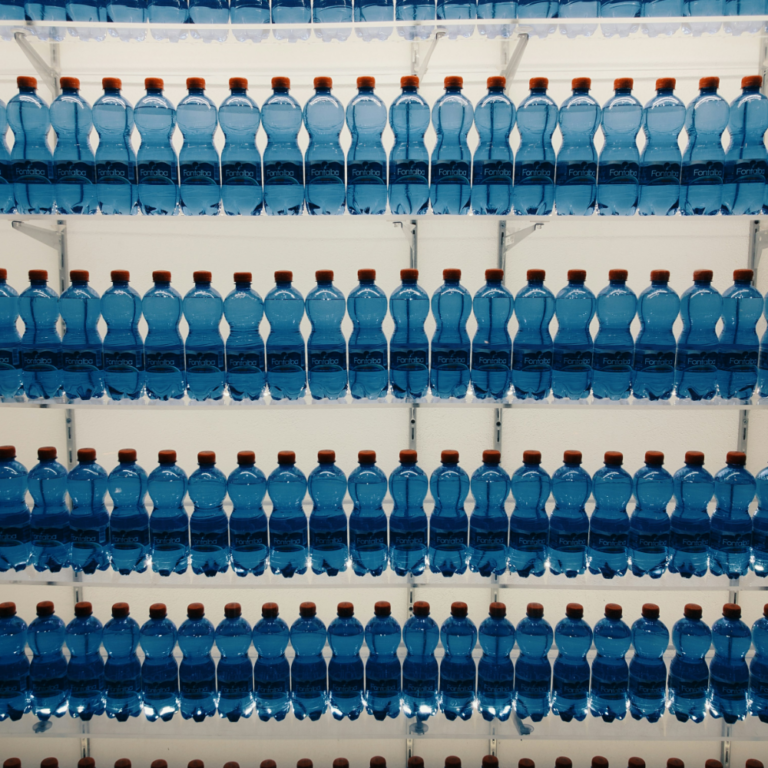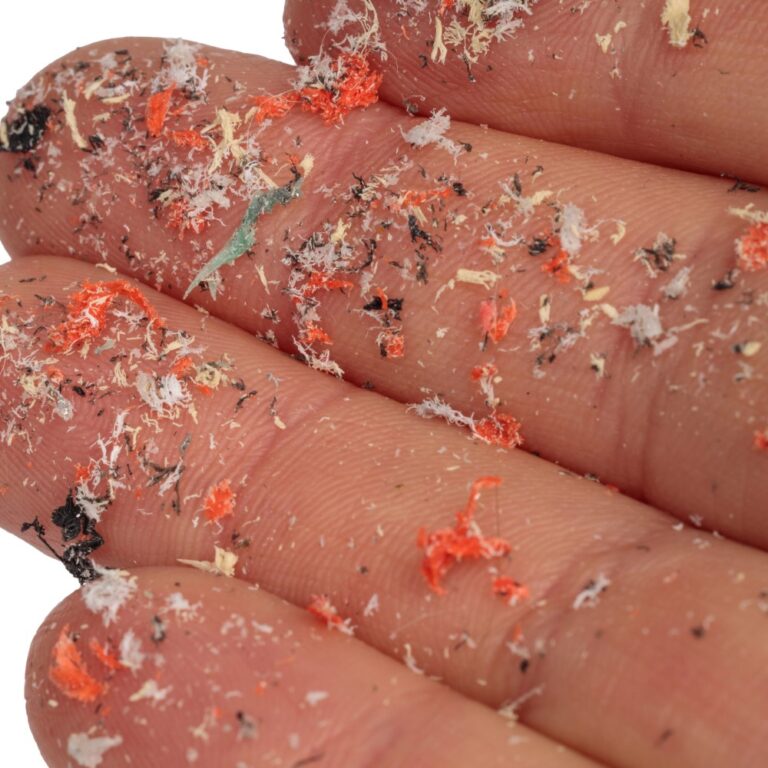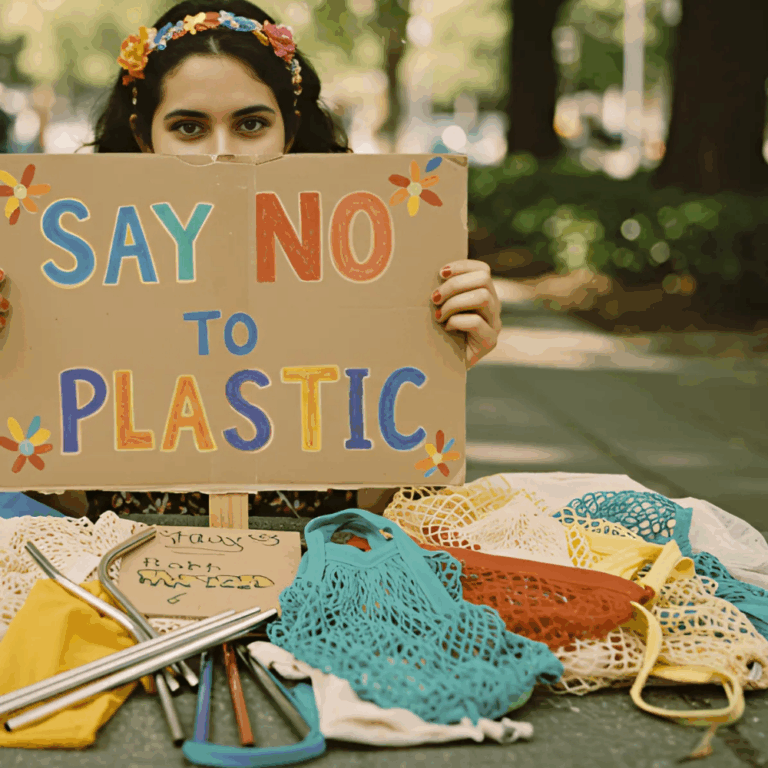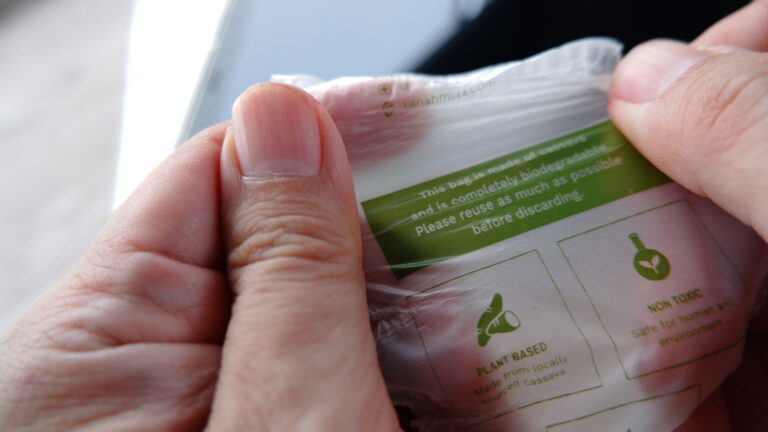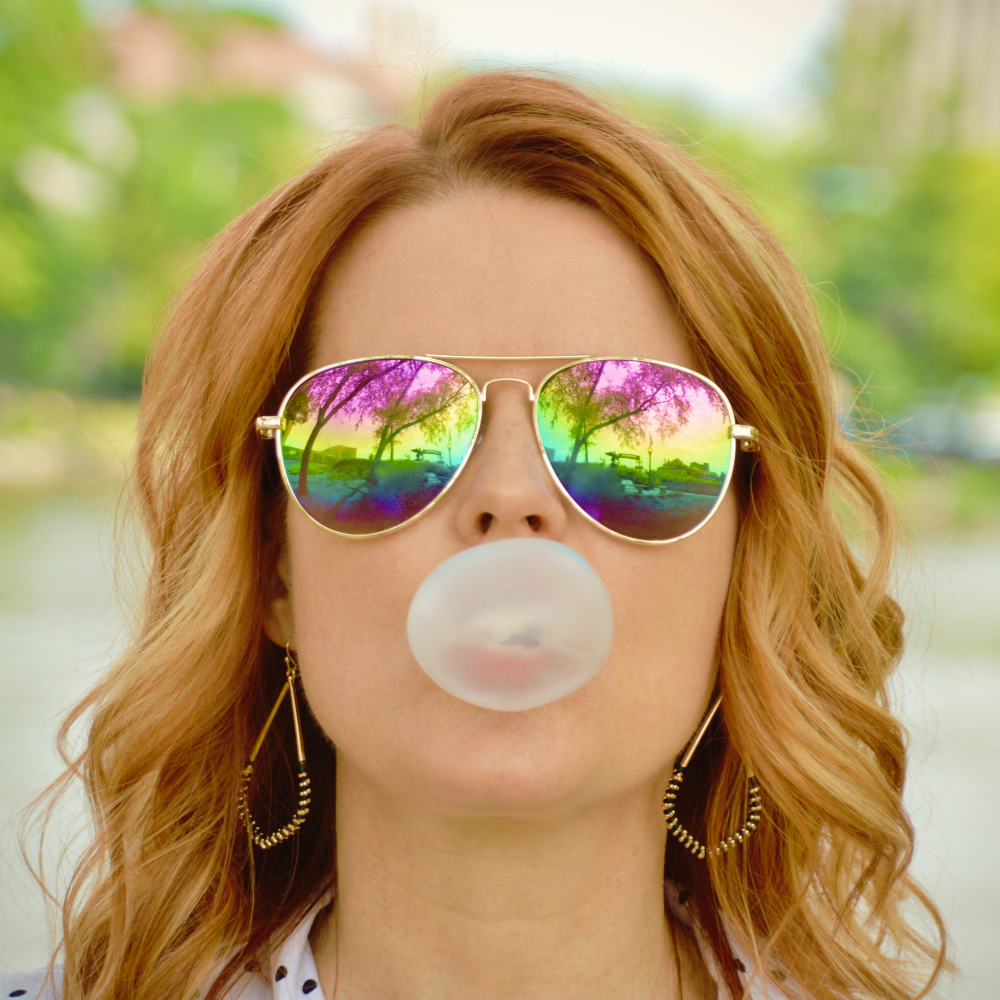
Key Takeaways
- Most conventional gum contains hidden plastics like polyethylene and polyvinyl acetate—the same materials used in glue and plastic bags.
- Plastic free gum uses natural, biodegradable bases such as chicle or mastic resin instead of petroleum-derived polymers.
- Choosing plastic free gum helps reduce microplastic pollution, avoids synthetic additives, and supports cleaner, healthier chewing habits.
Chewing gum has been around for centuries, from ancient tree resins to the minty sticks we pop in our mouths today. It’s one of those small, everyday habits that feels harmless, even refreshing, after a meal or during a long day.
But here’s the sticky truth: most modern chewing gum isn’t made from natural sap anymore. It’s made with plastic — the same kind used in water bottles, car tires, and glue. And according to new research from Queen’s University Belfast, a single piece of conventional gum can release over 250,000 microplastic particles into your saliva after just one hour of chewing. So every bite might be coating your mouth with tiny plastic fragments you never intended to swallow.
If you’re curious (or a little horrified) about what’s actually in traditional gum and what better options are out there, you’re in the right place. Let’s take a closer look at what’s hiding in your chew and the plastic-free gums that are changing the game.
Why Most Gum Contains Plastic
If you’ve ever glanced at a gum label and spotted the words “gum base,” you’ve already seen the mystery ingredient that hides the problem. “Gum base” sounds simple enough, but companies aren’t required to disclose what’s actually in it, and that’s where plastic sneaks in.
Most commercial gum bases are made from synthetic polymers such as polyethylene (the same plastic used in shopping bags) and polyvinyl acetate (an ingredient also found in wood glue). These plastics are what give gum its chewiness and shelf life, but they’re also what make it non-biodegradable. Once discarded, that wad of gum can stick to sidewalks or trees for years, slowly breaking apart into microplastics.
Why It Matters for Health and the Planet
Those microplastics don’t just litter city streets; they wash into waterways and soils, adding to the growing global pollution crisis. And it doesn’t stop with the environment — the plastic particles can also enter your body while you chew.
Many people assume gum is “food-grade” and safe to consume, but the truth is it’s classified as a non-food product under most regulations. That means manufacturers can use a broad mix of synthetic ingredients without fully disclosing them. The result? You could be chewing on plastics, petroleum resins, and softeners every time you reach for a stick.
Learn More: What Are Microplastics? Learn what microplastics really are, where they come from, and how they end up in products like chewing gum and the environment around us. Read more →The Impact of Plastic in Gum
Most people are shocked to learn that something as small as a piece of chewing gum can be a hidden source of plastic. The clue is in that vague ingredient you’ll find on nearly every pack: “gum base.” It sounds harmless, but it’s really a catch-all term for the blend of materials that gives gum its chewiness and long-lasting stretch.
Here’s the problem: companies aren’t required to say what’s actually in that base. And in most cases, it includes synthetic polymers, which are just another way of saying plastic. Over time, gum makers swapped out natural ingredients like chicle (a biodegradable tree sap) for cheaper, more durable materials like polyvinyl acetate (yep, the same thing found in glue) and polyisobutylene (used in tire inner tubes). Because “gum base” is so vague, there’s no easy way for consumers to know whether they’re chewing plastic or not.
Health Concerns You Can’t See
Recent research from Queen’s University Belfast found that conventional gum can shed hundreds of thousands of microplastic particles during an hour of chewing, turning each piece into a concentrated source of invisible plastic exposure. Some of those particles are swallowed, meaning tiny fragments of plastic may be entering your body with every chew. Scientists have already detected microplastics in human blood, lungs, and digestive systems, and while research is ongoing, early studies link them to inflammation and potential hormone disruption.
A Sticky Problem for the Planet
Plastic-based gum doesn’t break down naturally. Instead, it lingers, sticking to sidewalks, benches, and streets, where it can take decades to degrade. It’s estimated that gum is the second-most-common form of litter worldwide. Because it contains plastic, it eventually breaks down into microplastics that contaminate soil and waterways and harm wildlife.
Every piece of plastic gum that’s chewed and tossed adds to the pollution problem — one tiny habit multiplied by millions of people, every single day.
What Makes Gum Plastic Free?
Plastic-free gum brings chewing back to its natural origins. Instead of hiding synthetic plastics under the vague label “gum base,” these gums are made with pure, plant-based ingredients that come straight from nature and safely return to it.
The Core Difference
Plastic-free gum is made from materials that are biodegradable and renewable, not petroleum-derived. That means when you’re done chewing, it naturally breaks down over time instead of sticking around as microplastic waste.
Natural Ingredients That Make the Difference
- Chicle – A biodegradable latex from the sapodilla tree, long used as the original gum base before synthetics took over.
- Mastic Resin – Harvested from the mastic tree, this resin creates a clean, firm chew and offers a subtle, refreshing flavor.
- Spruce Resin – Used for centuries by Indigenous peoples, it’s fully biodegradable and has a light piney taste.
- Gum Arabic – A sap from acacia trees that acts as a natural binder and softener, giving gum its smooth texture.
Biodegradable by Design
Because these ingredients come directly from trees and plants, they naturally decompose, leaving no microplastics behind. Many plastic-free gum brands also extend this sustainability to their packaging, using recyclable boxes or compostable pouches instead of plastic blister packs.
How to Identify Truly Plastic Free Gum
Finding a genuinely plastic-free gum can be tricky — packaging claims like “natural” or “eco-friendly” don’t always tell the whole story. The secret is in the ingredient list. Here’s how to spot the real thing and avoid being misled by clever marketing.
✅ Good Ingredients to Look For
These are the natural, biodegradable ingredients that make up a true plastic-free gum base:
- Chicle – Natural tree sap from the sapodilla tree that gives gum its chewiness without any synthetic polymers.
- Mastic Resin – A plant resin from the Mediterranean mastic tree; firm, aromatic, and completely biodegradable.
- Spruce Resin – Naturally harvested and used for centuries as a clean, sustainable chew.
- Gum Arabic – Sap from acacia trees that acts as a natural binder and softener.
- Xylitol or Stevia – Plant-based sweeteners that freshen breath and, in the case of xylitol, support dental health.
- Essential Oils – Natural flavorings like peppermint, spearmint, or citrus extracts instead of synthetic additives.
❌ Ingredients to Avoid
If you see these on the label, the gum likely contains plastic or synthetic compounds even if it claims to be “natural”:
- Gum Base (without details) – A red flag term that often hides a mix of plastics, rubbers, and resins.
- Polyvinyl Acetate (PVA) – A synthetic polymer also used in glue.
- Polyethylene (PE) – The same plastic used in shopping bags.
- Butyl Rubber or Isobutylene – Commonly used in tire production.
- Artificial Colors and Flavors – Often petroleum-derived and unnecessary in natural gum.
- Aspartame or Acesulfame K – Artificial sweeteners that don’t belong in a clean, plant-based product.
✨ tip
Quick Label Check
If the ingredients list doesn’t specify what’s in the gum base, assume it contains plastics. Authentic plastic-free gum brands are transparent about their ingredients; they’ll proudly list chicle, resin, or plant sap right on the label.
Benefits of Plastic Free Gum
Switching to plastic-free gum isn’t just about what you avoid; it’s about choosing something cleaner, safer, and more sustainable from start to finish.
🩺 Health Benefits
- No microplastics in your mouth: Studies show traditional gum can release thousands of microplastic particles per piece into your saliva.
- Avoids synthetic polymers: Most conventional gum bases contain plastics like polyvinyl acetate (used in glue) and polyisobutylene (used in tires).
- Fewer hidden chemicals: Plastic-free gums skip petroleum-derived ingredients and artificial additives, which are often linked to health risks.
- Natural ingredients: Many use chicle, mastic, or other plant resins — biodegradable bases your body can trust.
🌍 Environmental Benefits
- Biodegradable gum base: Plastic-free gum naturally decomposes, helping reduce street litter and long-term pollution.
- Less street waste: Conventional gum is one of the world’s most common forms of urban litter — plastic-free options don’t stick around for decades.
- No contribution to microplastic pollution: Prevents microplastics from spreading into waterways, soil, and wildlife habitats.
🤝 Ethical & Transparency Benefits
- Clearer labeling: Plastic-free gum brands proudly list every ingredient — unlike “gum base,” which can hide up to 46 different substances.
- Supports eco-conscious companies: Most prioritize sustainable sourcing, fair labor, and minimal packaging waste.
- Consumer empowerment: You know exactly what you’re chewing and where it comes from.
😋 Sensory & Experience Benefits
- Cleaner taste: Without artificial sweeteners or synthetic flavors, the taste feels more natural and refreshing.
- Better texture: Many find that natural gums offer a smoother, longer-lasting chew and a warmer, longer-lasting flavor once warmed in the mouth.
- Peace of mind: Every chew feels better when you know it’s plastic-free and planet-friendly.
8 Plastic Free Gum Brands to Try
Ready to make the switch to a cleaner chew? Here are some standout plastic-free gum brands that prioritize natural ingredients, sustainability, and great taste:
| Brand | Base Ingredient | Sweetener | Vegan | Special Features | Packaging |
|---|---|---|---|---|---|
| Refresh Gum | Chicle (tree sap) | Xylitol, Calcium Carbonate | ✓ | Mineral-infused for enamel support, strong mint flavor, plastic-free | Recyclable paper box |
| Chewsy Gum | Chicle | Xylitol | ✓ | Sugar-free, supports dental health, plastic-free | Recyclable paperboard box |
| Nathan & Sons | Chicle, Mastic, Spruce Resin | Xylitol, Erythritol, Minerals | ✓ | Remineralizing formula, handcrafted, biodegradable gum base | Recyclable box |
| Simply Gum | Chicle, Candelilla Wax | Organic Cane Sugar | ✓ | Compostable wrappers, transparent ingredients, handcrafted look | Cardboard box with post-chew wraps |
| Milliways | Chicle | Xylitol, Stevia | ✓ | Plant-based, balanced flavor, sustainable UK brand | Plastic-free recyclable box |
| Honest Gum | Chicle | Xylitol | ✓ | Vegan, no synthetic additives, natural plant-based oils | Home-compostable, plastic-free |
| Georganics | Chicle | Xylitol | ✓ | Oral care focus, peppermint essential oil, fluoride-free | Recyclable paper box |
| Cerez Pazari Natural Mastic Gum | Pure Mastic Resin (Chios tree sap) | None — unsweetened natural resin | ✓ | Traditional Greek mastic gum, no additives or flavors, fully biodegradable | Paper pouch or box (varies by retailer) |
Note: Natural gums made from chicle, mastic, or spruce resin are biodegradable, while synthetic gum bases can persist for decades as microplastics. Not all plastic-free gums are automatically vegan — certification depends on ingredient sourcing.
Refresh Gum
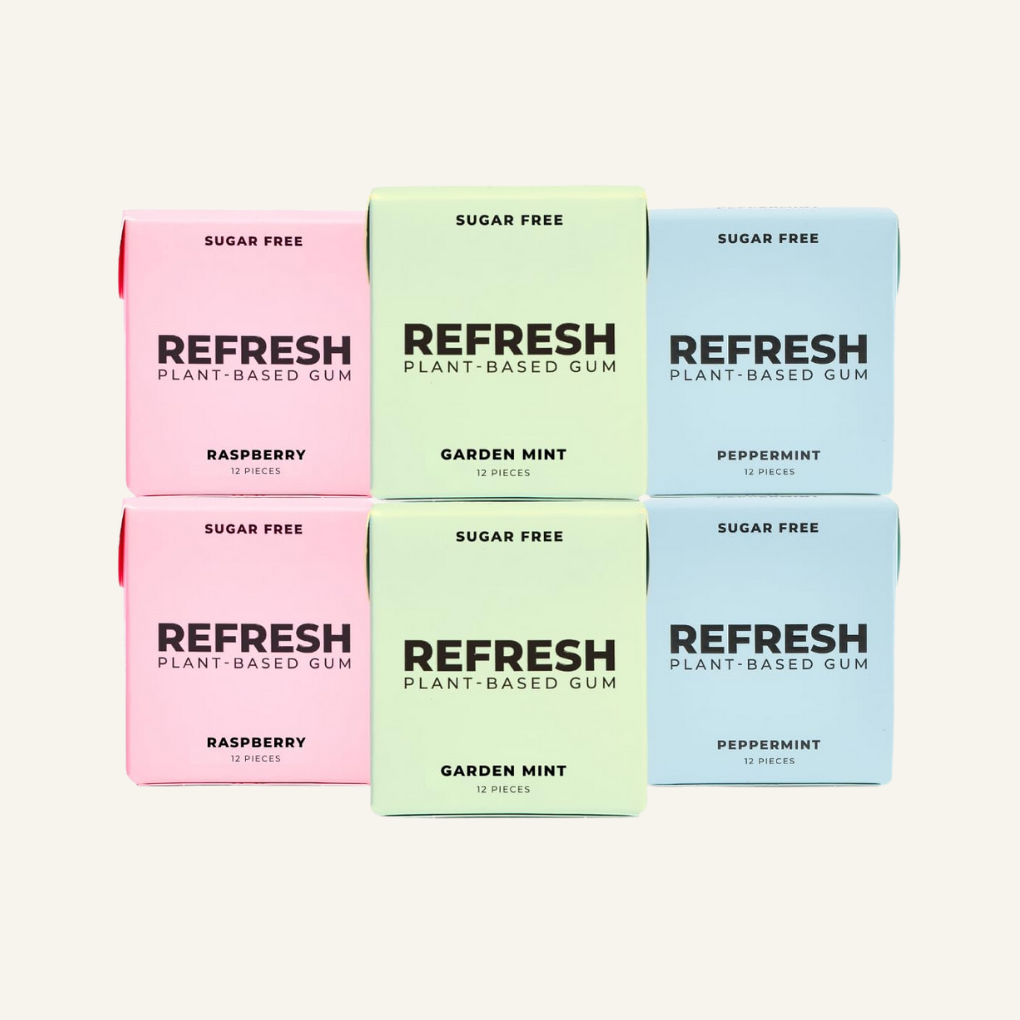
Refresh Gum is a plastic-free, mineral-infused chewing gum designed with both oral health and sustainability in mind. Instead of synthetic polymers like polyvinyl acetate, it uses a natural chicle base, a biodegradable tree sap traditionally harvested in Central America. This gives the gum its familiar chew without any hidden plastics or petrochemical ingredients.
Each piece is vegan, aspartame-free, and sweetened with xylitol and calcium carbonate, ingredients known to help neutralize acids and support enamel strength.
The formula skips artificial colors, preservatives, and synthetic additives, offering a clean, refreshing chew that feels truly natural.
Personal Review
I tried the peppermint flavor, and it delivers a strong, cooling mint kick with a satisfying crunchy outer shell that softens quickly into a smooth, even chew.
I’d repurchase it for sure and I’m curious to see how the other flavors compare.
Chewsy Gum
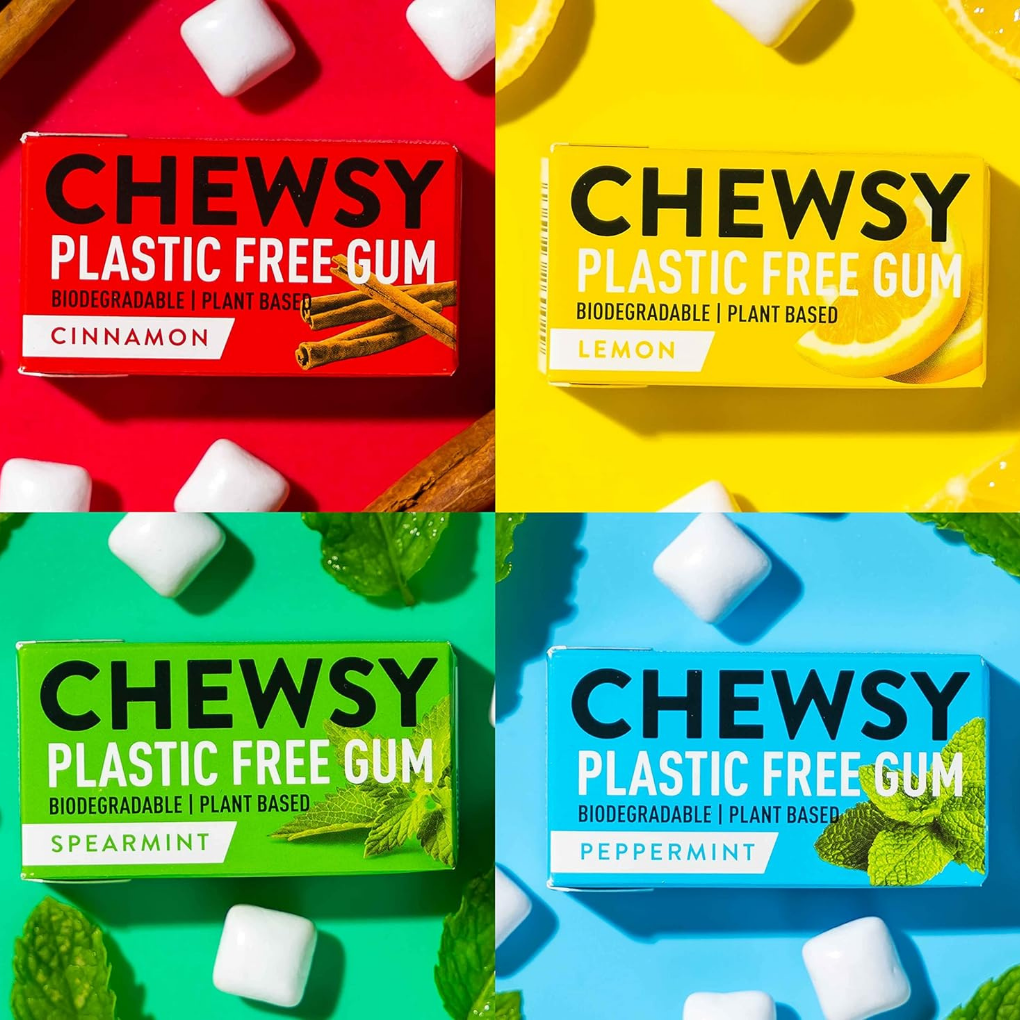
Chewsy is a plant-based, plastic-free gum made with chicle, a biodegradable tree sap from Central America that replaces the synthetic “gum base” used in most conventional gums.
Each piece is sugar-free and aspartame-free, sweetened with xylitol, which helps reduce plaque and support oral health.
The gum comes in a recyclable paperboard box, not a plastic blister pack, and the flavors — peppermint, spearmint, and lemon — are bright, natural, and refreshing.
Nathan & Sons Remineralizing Gum
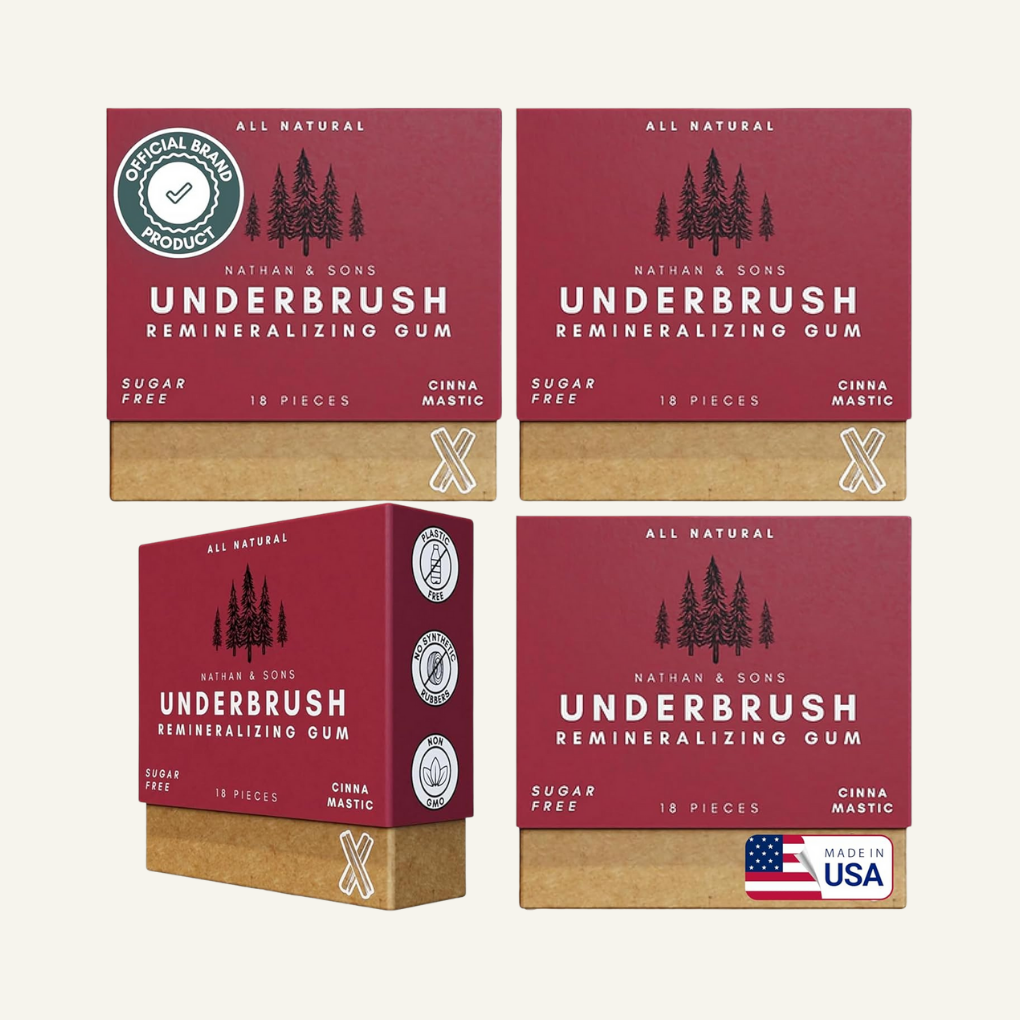
Nathan & Sons crafts small-batch, plastic-free gum using a blend of traditional tree saps — chicle, mastic, and spruce resin — for a naturally chewy, fully biodegradable base.
Sweetened with xylitol and remineralizing minerals, this gum helps support enamel strength and reduce acid buildup, making it both functional and natural.
Each batch is handcrafted, giving it a premium, artisanal feel that sets it apart from mass-produced options.
Packaged in a simple recyclable box, Nathan & Sons delivers a smooth chew, subtle sweetness, and an elevated take on what truly natural gum can be.
Simply Gum
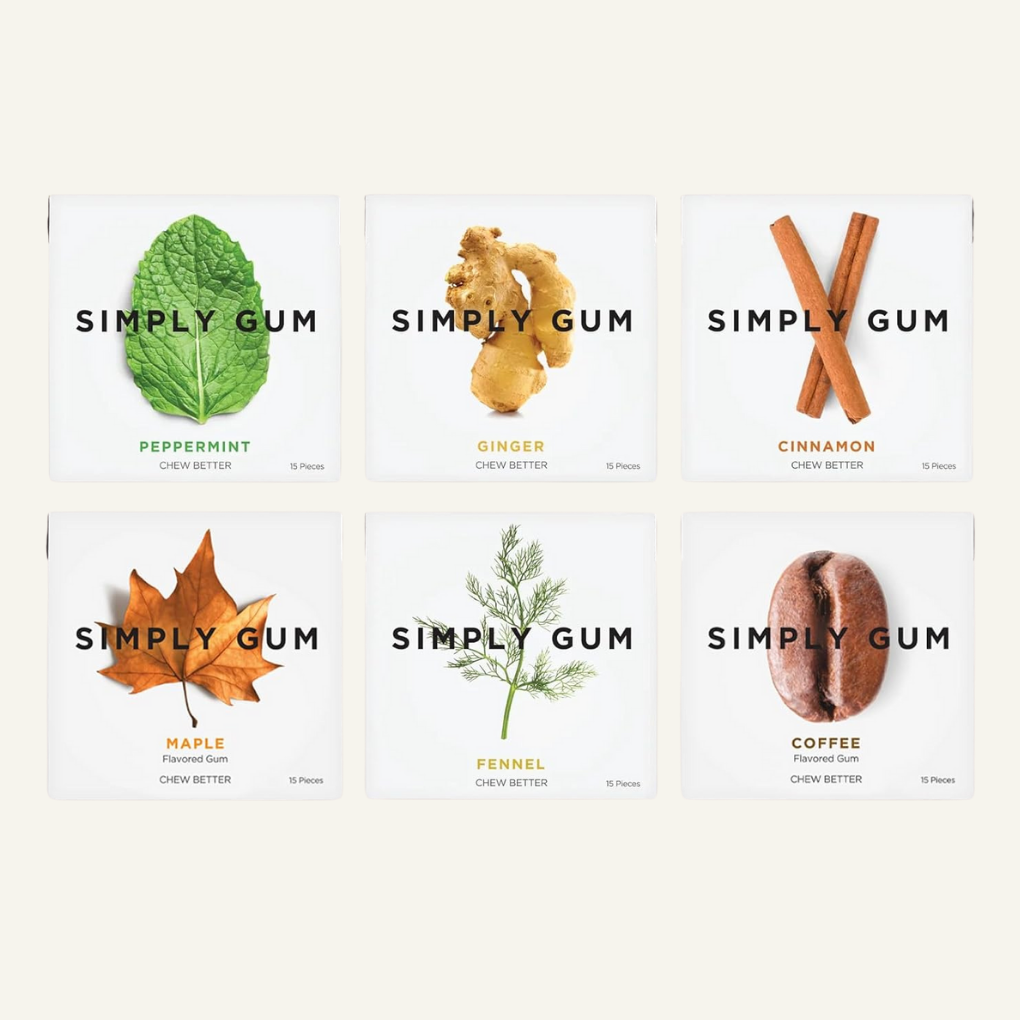
Simply Gum is one of the original plastic-free chewing gum brands and helped pave the way for cleaner, more transparent ingredients in the gum aisle. Made with a natural chicle base and candelilla wax, it skips synthetic polymers and petroleum-based fillers entirely.
The gum is sweetened with organic cane sugar and flavored with real plant extracts, offering a mild, natural sweetness without artificial additives.
It’s also certified vegan, non-GMO, and made in small batches to maintain quality and freshness.
Simply Gum comes in a cardboard box with convenient post-chew wraps, so you always have a way to dispose of it responsibly.
Flavors like peppermint, cinnamon, and ginger are subtle yet clean, making it a solid choice for anyone who prefers natural ingredients over intense, artificial sweetness.
Personal Review
I tried the spearmint flavor and really liked the clean, refreshing taste, though the flavor didn’t last very long.
The texture was a bit firmer than I expected, but I loved the simple, handcrafted look that clearly feels plastic-free.
The post-chew wraps included in the box are a smart and thoughtful touch.
Milliways Gum
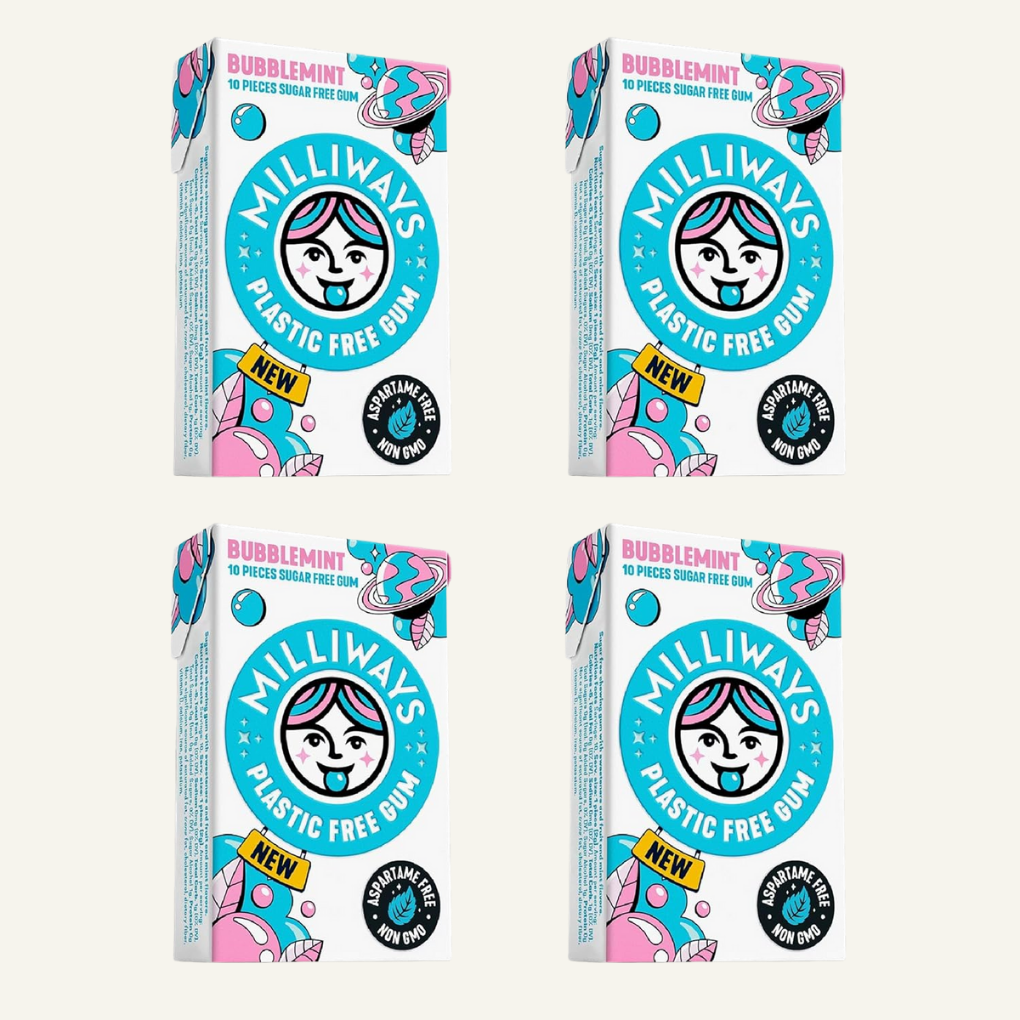
Milliways is a UK-based, plastic-free gum brand known for its clean ingredients and sustainable approach. Made with a natural chicle base, it skips the synthetic polymers used in conventional gum.
It is sweetened with xylitol and stevia for a gentle, naturally derived sweetness that supports oral health without added sugar.
The gum has a smooth, balanced chew with flavors like peppermint, spearmint, and tropical mango, each offering a fresh, natural taste without being overly sweet. Packaged in a plastic-free, recyclable paper box,
Honest Gum
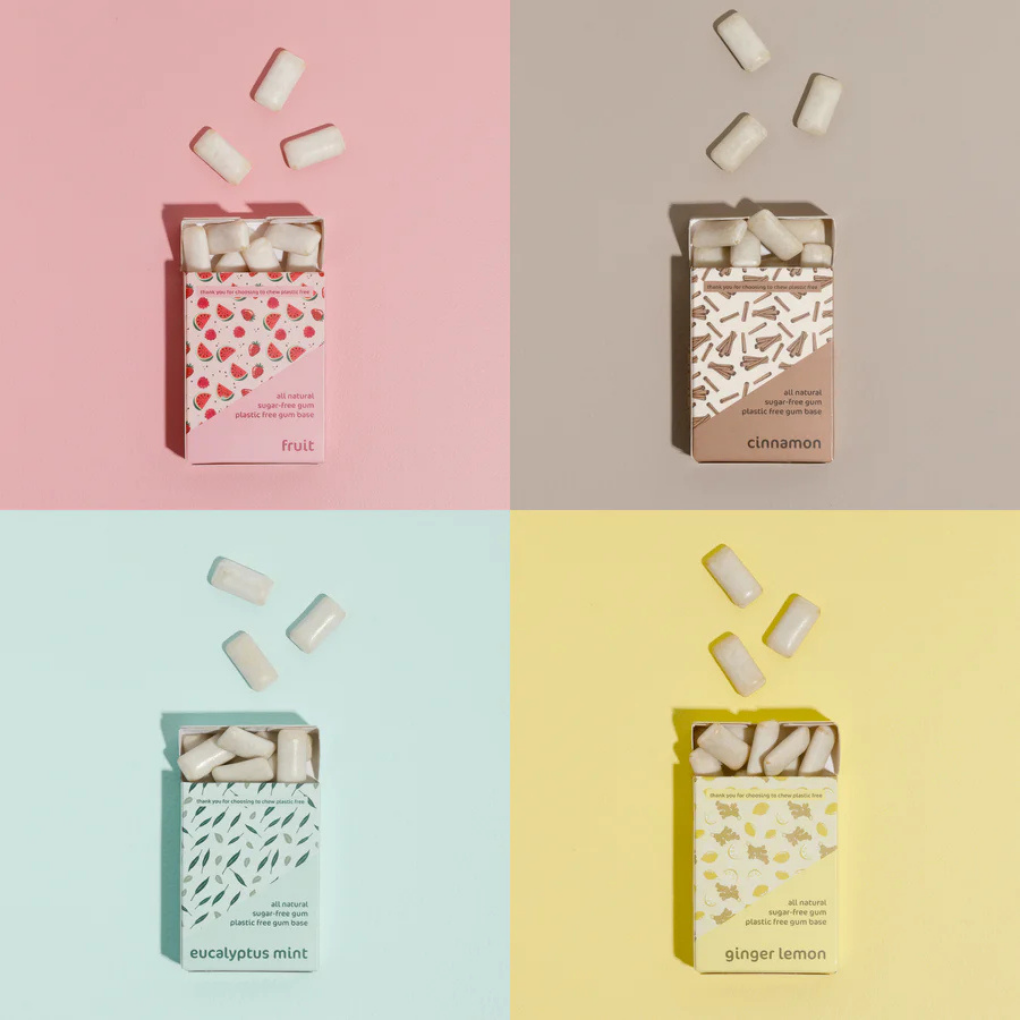
Honest Gum is an Australian brand that makes chewing gum the old-fashioned way with natural chicle.
The gum is vegan, plastic-free, and sweetened with xylitol, which helps protect teeth and freshen breath without artificial sweeteners or colors.
It’s free from synthetic additives and preservatives, so what you see on the label is precisely what you’re chewing.
Each pack comes in home-compostable, plastic-free packaging, making it easy to dispose of responsibly. Honest Gum offers classic flavors like peppermint and lemon, both light and refreshing, made with real plant-based oils.
Georganics Gum
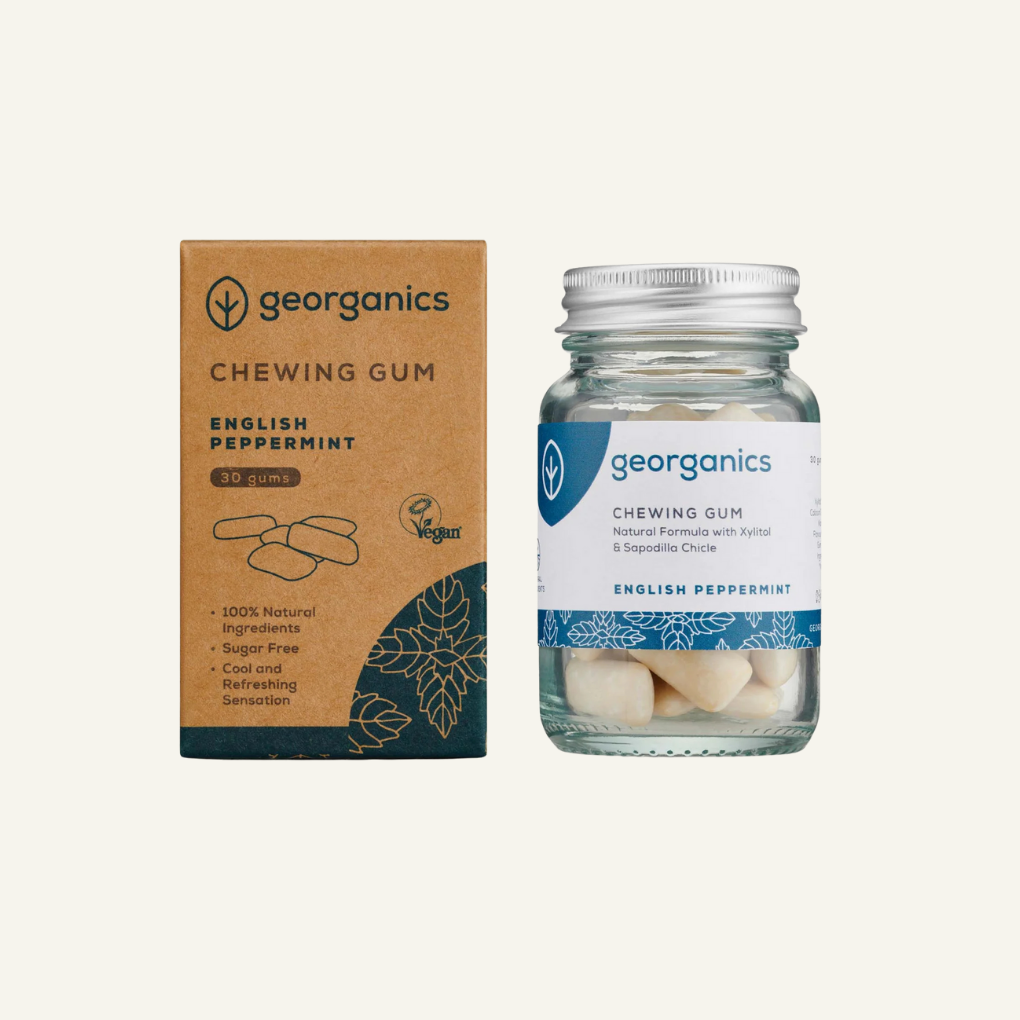
Georganics is a UK oral care brand known for using simple, natural ingredients in everything they make. Their gum is made with a natural chicle base, so it’s fully biodegradable and completely free from plastic, artificial sweeteners, and preservatives.
It’s sweetened with xylitol, which helps fight the bacteria that cause cavities, and flavored with organic peppermint oil for a cool, fresh taste that isn’t too strong. The gum comes in a recyclable paper box, keeping it plastic-free from start to finish.
Cerez Pazari Mastic Gum
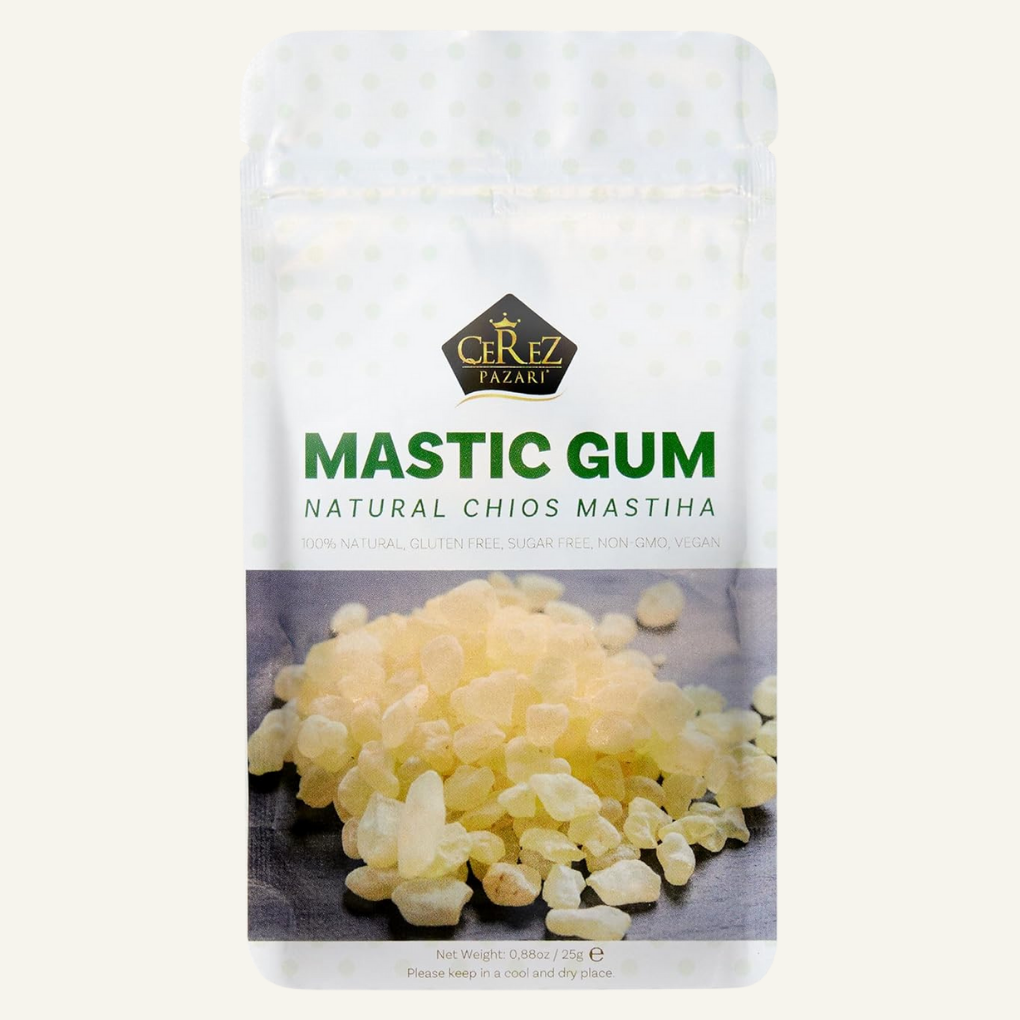
Cerez Pazari produces traditional mastic gum from pure resin extracted from mastic trees grown on the Greek island of Chios.
This type of gum has been used for centuries, long before synthetic gums existed, and is entirely natural and biodegradable.
Unlike most gums, it has no added sweeteners, flavors, or colors. You’re literally chewing tree resin, which starts firm and softens as you chew.
The flavor is slightly pine-like and earthy, very different from modern mint gums, but that’s part of its natural charm.
Because it’s just mastic resin, it’s free from plastics, chemicals, and additives, making it one of the cleanest and most authentic gums you can buy.
Plastic-Free Gum Isn’t Perfect — Here’s What to Expect
Switching to plastic-free gum is a simple change that can make a real difference. It cuts out hidden plastics, reduces waste, and keeps ingredients closer to their natural state. Just keep in mind that natural gums feel a little different than the ones made with synthetics, and that’s completely normal.
🫧 Flavor and Texture Feel Different
Plastic-free gum often has a subtler flavor that fades more quickly. It doesn’t have the artificial sweeteners or plasticizers that stretch flavor for hours. Chicle-based gums can start a bit firm, then soften as they warm in your mouth. If you’re used to a super-bouncy texture, this will feel different, but many people say it tastes cleaner and more natural once they adjust.
⏳ Shorter Shelf Life (and That’s a Good Thing)
Because these gums skip preservatives, they can dry out sooner —usually within a few months of opening. That’s actually a good sign: it means the ingredients are real, not engineered to last forever. Store them in a cool, dry spot and keep the box sealed to maintain freshness.
💸 Higher Price, Smaller Batches
Plastic-free gum costs more than mass-produced brands, mainly because it’s made in small batches with natural ingredients like chicle or mastic. Think of it like choosing organic produce; you’re paying for quality and ethics, not plastic fillers. Prices usually range from $3–$5 a box, and most are easy to find online.
🔍 Ingredient Transparency Still Varies
Most natural gum brands list every ingredient proudly, but a few still use vague terms like “gum base.” If the brand doesn’t explain what’s in it, that’s a red flag. Look for companies that clearly name their ingredients, such as chicle, mastic, or resin, so you know exactly what you’re chewing.
♻️ Packaging Matters Too
Some gums come in compostable pouches, others in recyclable paper boxes. Both are great alternatives to plastic blister packs, but it’s worth checking if the brand’s packaging is certified compostable or recyclable in your area.
✨ tips
Reducing Plastic Exposure
Make smarter choices to cut down your plastic intake—starting with what you chew and extending to daily routines:
- Read ingredient lists carefully: Choose gum brands that clearly list natural bases like chicle, mastic, or spruce resin—avoid vague terms like “gum base” or ingredients such as polyvinyl acetate and polyethylene.
- Chew less, chew longer: Most microplastics are released in the first few minutes. Chewing one piece for longer can help minimize your total exposure.
- Skip gum for kids: Children are more sensitive to chemical exposures, so consider limiting their gum intake or opting for verified, plastic-free brands.
- Ditch single-use plastics elsewhere: Carry a reusable water bottle and avoid plastic-wrapped snacks to reduce your daily plastic intake further.
- Choose plastic-free packaging: Pick gum (and other products) that use recyclable or compostable materials to avoid hidden sources of plastic.
FAQs on Plastic Free Gum
Yes. Most plastic-free gums use natural ingredients like chicle or xylitol, which are generally safe for children over 5 who can chew gum without swallowing it. Just remember that xylitol is toxic to dogs, so keep gum out of reach of pets.
Definitely, natural gums made with peppermint, spearmint, or essential oils freshen breath without synthetic flavors or artificial sweeteners. Some also help reduce bacteria that cause odor.
You can throw it in your home compost bin or general waste — it will biodegrade over time. Just avoid tossing it outdoors where wildlife could mistake it for food.
Under current FDA regulations, manufacturers can list “gum base” without disclosing ingredients, and many include polymers approved for food contact (21 CFR § 172.615). Until labeling rules change, it’s up to consumers to choose transparent brands.
Final Thoughts About Plastic Free Gum
Plastic-free gum might seem like a small change, but it matters. By choosing natural ingredients over hidden plastics, you’re keeping microplastics out of your mouth, supporting sustainable brands, and helping reduce pollution with every chew. It’s proof that even everyday habits — like grabbing a stick of gum — can be part of a cleaner, healthier future.
📚 References
- American Chemical Society. (2025, March 27). Chewing gum can shed microplastics into saliva, pilot study finds [Press release]. American Chemical Society. https://www.acs.org/pressroom/presspacs/2025/march/chewing-gum-can-shed-microplastics-into-saliva-pilot-study-finds.html
- Jones, D. (2025, March 17). Chewing gum is plastic pollution, not a litter problem. Phys.org. https://phys.org/news/2025-03-gum-plastic-pollution-litter-problem.html
- Queen’s University Belfast. (2025, March 26). Stop chewing: New research reveals the shocking number of microplastics in a single piece of gum. Queen’s University Belfast. https://www.qub.ac.uk/News/Allnews/2025/StopchewingNewresearchrevealstheshockingnumberofmicroplasticsinasinglepieceofgum.html
- U.S. Food and Drug Administration. (n.d.). 21 CFR § 172.615 — Chewing gum base. Electronic Code of Federal Regulations. https://www.ecfr.gov/current/title-21/chapter-I/subchapter-B/part-172/subpart-G/section-172.615
